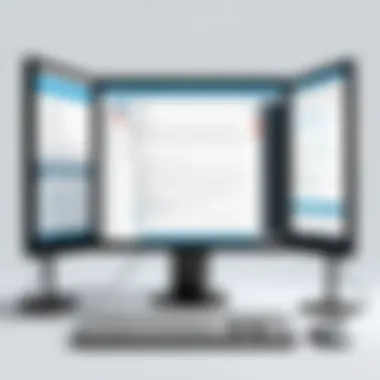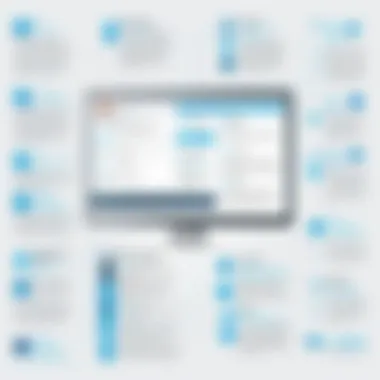Exploring Turnitin: Free Access and Alternatives


Intro
Turnitin is widely recognized in academic circles for its effectiveness in detecting plagiarism. It serves as an essential tool for educators, researchers, and students seeking to maintain academic integrity. However, the cost associated with its subscription can be a barrier for many. This article seeks to explore the accessibility of Turnitin, particularly focusing on whether users can gain free access to its services. In addition, we will assess alternative tools that can provide similar functionalities at no cost. Understanding these options is crucial not only for students but also for professionals in various fields who may face similar challenges.
Brief Description
Overview of the software
Turnitin is a web-based application primarily used for checking the originality of written works. It operates by comparing submitted documents against a vast database, which includes web pages, academic articles, and student papers. This enables it to effectively flag instances of potential plagiarism. Additionally, Turnitin offers tools for peer review and grading, enhancing its utility in an educational context.
Key features and functionalities
Turnitin boasts several key features:
- Plagiarism detection: Automatically scans submitted documents and highlights potential matches.
- Feedback Studio: A platform for educators to provide comments and feedback directly on submitted works.
- GradeMark: An integrated grading tool that simplifies the grading process through a digital rubric.
- PeerMark: Allows students to review and comment on each other’s work, promoting collaborative learning.
These features make Turnitin a comprehensive solution for academic institutions and companies focused on maintaining quality and originality in their written content.
System Requirements
Hardware requirements
To run Turnitin effectively, users need the following minimum hardware specifications:
- Processor: 2 GHz or higher
- RAM: 4 GB or more (8 GB recommended for optimal performance)
- Storage: At least 500 MB of available space
Software compatibility
Turnitin is compatible with modern web browsers. Users should ensure they are using the latest versions of:
- Google Chrome
- Mozilla Firefox
- Safari
- Microsoft Edge
Utilizing up-to-date software ensures a smooth experience while accessing Turnitin's functionalities.
"Knowledge is power. Information is liberating. Education is the premise of progress, in every society, in every family." — Kofi Annan
Preface to Turnitin
Understanding Turnitin is essential for students, educators, and professionals dealing with academic integrity. This section will explore the foundational aspects of Turnitin, shedding light on why it remains a critical tool in academic circles. With the rise of online learning and digital submissions, plagiarism detection has become more crucial than ever. Turnitin offers solutions to ensure original work and promote proper attribution in academic writing.
What is Turnitin?
Turnitin is a plagiarism detection software widely used by educational institutions. Its primary function is to check submitted papers against a vast database of academic work, web pages, and publications. This comparison helps identify similarities and potential instances of plagiarism. Educators utilize Turnitin to uphold academic integrity by ensuring that students understand and adhere to ethical writing practices.
Turnitin operates on a subscription model, requiring institutions to pay for access. However, individuals and institutions can explore alternatives for free or lower-cost options.
Purpose and Functionality


The primary purpose of Turnitin is to create a culture of honesty in academic writing. Its functionality includes several key features:
- Plagiarism Detection: Scans documents for similarities with existing sources.
- Feedback Studio: Provides tools for instructors and students to give feedback on submissions.
- GradeMark: Allows teachers to grade assignments electronically and leave comments.
These features help reduce academic misconduct by promoting original work. Additionally, Turnitin assists educators in identifying common areas where students struggle, allowing for tailored teaching strategies.
Overall, Turnitin plays a significant role in promoting ethical academic practices and enhancing overall educational outcomes.
Understanding Turnitin's Business Model
Understanding Turnitin's business model is vital for those assessing its utility in academic and professional settings. This section examines how Turnitin generates revenue, the types of access individuals and institutions can expect, and the implications of its pricing strategies. Knowing the business model also assists users in navigating incompatible solutions and assessing the overall opportunity cost associated with using the service.
Subscription-Based Access
Turnitin primarily operates on a subscription-based model. This means that users or institutions pay a recurring fee to access its services. Typically, this model benefits educational institutions, which can provide services to all their students and faculty members. The subscription covers a variety of features, such as originality checking, grading tools, and tailored feedback options.
The benfit of subscription-based access is its predictability in costs for institutions. Schools and universities can budget effectively for these services annually. Moreover, they can adapt their subscriptions as needed. Some institutions offer different tiers of subscriptions, which may include additional features or enhanced support. This flexibility is essential for academic environments, where the needs of students and faculty can vary significantly.
On the other hand, individual users might find the costs prohibitive. Some private users have to choose between accessing Turnitin as a personal user or using alternative options. This limitation can restrict access for independent researchers or professionals, leading to some frustration within the user base.
Institutional Licensing
Institutional licensing is another key component of Turnitin's business model. In this framework, organizations negotiate contractual agreements to provide access to their staff and students. This approach streamlines the process as institutions manage account creation and usage tracking internally.
Through institutional licensing, users can access Turnitin's entire suite of tools without having to deal with individual subscriptions. The tool becomes an integrated part of the institution's resources, often making it more accessible and easier to use than when individuals sign up independently. Additionally, institutional licenses often include training for educators and staff, which enhances the effective implementation of Turnitin's features.
However, there are challenges with institutional licensing as well. Institutions may face obstacles like prolonged negotiation processes or the inability to tailor the software's functionality to their specific needs. Furthermore, smaller institutions may struggle to afford comprehensive subscriptions, limiting their students and faculty's ability to use the tool.
Can You Use Turnitin for Free?
Understanding if you can use Turnitin at no cost is significant for many individuals and institutions. This inquiry touches on broader themes of academic integrity and compliance with educational standards. Given that Turnitin is widely recognized for its effectiveness in detecting plagiarism, the access issue becomes critical for those with limited resources. Students and educators alike benefit from having tools that facilitate honest scholarship without incurring substantial financial burdens.
Free Trials and Limited Access
Turnitin does provide occasional free trials, yet these periods of access typically come with constrictions. Free trials allow users to submit a number of papers without charge—often valuable for new users to gauge the interface and capabilities. Nevertheless, after the trial ends, long-term usage requires a paid subscription. Users must also be aware that the limited functions exposed during such trials do not always reflect the comprehensive capabilities available in the full version.
Furthermore, these trials often limit the number of submissions or the range of features that can be accessed. It is important to read the terms carefully; often, users find themselves surprised by restrictions. To maximize benefit from free access, users should focus on key functionalities they intend to evaluate, such as similarity reports and feedback mechanisms.
Academic Affiliations
For many students and educators, free access to Turnitin often hinges on academic affiliations. Most universities and colleges have licensing agreements with Turnitin. Departments usually integrate this tool within their courses. As a result, students using university-provided platforms often gain free access. They may require their institutional credentials for entry.
In addition, educators can leverage their institutions' resources to facilitate plagiarism checks for student assignments. Academic collaborations significantly enhance the utility of Turnitin, allowing institutions to promote academic integrity at a lower individual cost. However, for those outside established academic affiliations, exploring affiliations with they may not get access readily.
In summation, while free access to Turnitin is available under specific conditions, the access structure requires careful navigation. Those interested should evaluate their options, especially through academic channels, to determine the best pathways for utilizing Turnitin without incurring expenses.
Alternatives to Turnitin


In the realm of academic and professional integrity, the availability of various plagiarism detection tools has become increasingly crucial. Alternatives to Turnitin provide valuable resources for users who either do not have access to Turnitin or seek options that are more affordable or better suited to specific needs. These alternatives can deliver similar functionalities and assistance while catering to a wide range of users, from individual students to large educational institutions. By exploring these alternatives, one can gain insights into their effectiveness, usability, and how they fit into the existing landscape of plagiarism detection.
Other Plagiarism Detection Tools
Various plagiarism detection tools serve as alternatives to Turnitin, each exhibiting distinctive features and capabilities. Some of these tools include Grammarly, Copyscape, and Plagscan.
- Grammarly: Primarily an editing tool, Grammarly includes a plagiarism checker that scans for duplicate content online. It is suitable for people looking to refine writing while ensuring originality. However, its database may not be as extensive as specialized plagiarism detection tools.
- Copyscape: This service is geared more towards web content creators and businesses. It checks content against online sources to detect plagiarism effectively. Additionally, Copyscape offers a premium service that allows deep scanning of content for cost.
- Plagscan: Targeting both academic and corporate users, Plagscan has a user-friendly interface and provides comprehensive reports on text originality. It supports various file formats and integrates with Learning Management Systems (LMS), making it versatile for educational settings.
Evaluating these tools helps users find a balance between budget, specific needs, and the level of detail required in plagiarism detection.
Free and Open Source Options
For individuals or institutions on tight budgets, free and open source plagiarism detection tools present a compelling alternative to Turnitin. Some notable options include:
- Plagiarism Checker by Search Engine Reports: This user-friendly tool offers free scanning for plagiarism and generates detailed results. Although it is less comprehensive than paid tools, it caters well to students and freelancers seeking basic services.
- Plagiarism Detector: This free open-source tool allows users to check their text against online sources. While it lacks some advanced features and may have limitations on character count, it can be an effective resource for casual use.
- Quetext: A simple plagiarism checking platform that offers a limited free version. Users can conduct basic checks and receive a limited number of searches per month, making it useful for occasional users.
These options illustrate that finding plagiarism detection tools does not have to entail high costs. Users can navigate the landscape effectively, leveraging free tools as a valuable resource.
"The key to maintaining academic integrity is to make sure that you have the right tools for plagiarism detection at your fingertips."
Limitations of Turnitin's Free Access
Understanding the limitations of Turnitin's free access is critical for users who may rely on this service for detecting plagiarism. While Turnitin is a robust tool widely used by educational institutions, the limitations placed on its free access can significantly affect its functionality and usability. Recognizing these constraints helps users manage their expectations and explore alternative options that may better suit their needs.
Scope of Coverage
Turnitin’s free access does not encompass the full range of its capabilities. The scope of coverage typically refers to the databases and resources the tool can search through for potential plagiarism detection. Aid in accessing a vast repository of academic papers, internet content, and student submissions is common with paid subscriptions. However, when using Turnitin for free, users may only access a limited database, potentially overlooking critical similarities and sources. Academic journals, thesis papers, and unpublished works might not be included, thereby narrowing the effectiveness of the tool.
Additionally, users of free access might not benefit from real-time updates and expansions of Turnitin’s database. Educational institutions usually invest in comprehensive packages that allow for a more thorough scan, potentially missing in free versions.
Reporting Features
Reporting features are another crucial aspect where free access to Turnitin falls short. The paid version provides detailed reports that include percentages of matching text, links to source material, and even suggestions for revisions. In contrast, the free access may yield basic reports that lack depth, making it more challenging for users to understand the nature of detected similarities.
Without detailed feedback, users might find it difficult to rectify issues within their work effectively. The inability to receive a thorough breakdown hampers academic integrity, as students might not fully grasp where they have strayed into unintentional plagiarism. Therefore, relying on free versions can lead to oversights that ultimately affect the quality of submissions and the standing of users in academic circles.
"Using Turnitin without full access can be misleading, as individuals might operate under false pretenses regarding their work's originality."
Ethical Considerations
The topic of ethical considerations in the context of plagiarism detection tools such as Turnitin cannot be overstated. Ethical use is not just a set of guidelines; it forms the foundation for academic integrity and fair practices within educational and professional environments. When utilizing any plagiarism detection software, including Turnitin, users must navigate various ethical landscapes to ensure compliance with accepted standards.
Academic Integrity
Academic integrity is a principle that emphasizes honesty and responsibility in learning. It is crucial for maintaining the credibility of educational systems. Turnitin serves as a safeguard against academic dishonesty, providing institutions a means to uphold these values. However, it is essential to recognize that true academic integrity goes beyond merely avoiding plagiarism. It encompasses the cultivation of original thought and respect for intellectual property.
Using Turnitin responsibly requires understanding the ownership of ideas. Students must make conscious efforts to produce their work, acknowledging the importance of their unique contributions. When they submit their projects and papers, they should aim to enhance their learning experience rather than solely focus on avoiding penalties.


"Integrity is doing the right thing, even when no one is watching."
— C.S. Lewis
In this context, Turnitin can foster a supportive academic environment. It encourages students to engage with the materials genuinely while providing instant feedback on their writing. This guidance can contribute to a more ethical approach to learning, wherein authors take responsibility for their work.
Misuse of Free Tools
The misuse of free tools for plagiarism detection raises significant ethical questions. While many individuals may seek no-cost alternatives to Turnitin or exploit free trial versions, this practice can lead to unintended consequences. For one, reliance on these free resources can result in inadequate detection capabilities. Users may receive overly lenient verdicts on their work, leading to a false sense of security regarding originality.
Furthermore, some individuals may take advantage of free tools for dishonest purposes. Instead of using these resources as a means to learn from past mistakes, they may exploit them as loopholes to pass off others’ work as their own. This not only undermines the value of the educational process but also risks reputational damage for those institutions that fail to address such misuse effectively.
As such, users should exercise caution and strive for ethical engagement with free tools or services. They must be aware of their responsibilities not only to themselves but also to their peers and educators. Adopting a formal approach with available resources, regardless of cost, reflects a commitment to maintaining the integrity of academic standards.
Navigating Turnitin for Academic Use
Navigating Turnitin is essential for anyone involved in academia. With the growing emphasis on maintaining high academic integrity standards, knowing how to use Turnitin effectively becomes invaluable. The platform serves various stakeholders, including students, educators, and institutions. Familiarity with Turnitin enables users to understand how to manage submissions, interpret feedback, and utilize the tool to enhance their academic work.
Registration and Submission Process
To use Turnitin, the first step is registering for an account. Institutions typically provide access codes, linking users directly to their educational systems. However, individuals seeking independent access may encounter limitations. Once a user has registered, the submission process can begin. Each assignment must be uploaded carefully, ensuring that formats comply with Turnitin's guidelines. Common accepted formats include Word documents and PDF files.
Here are some key points about the registration and submission process:
- Obtain Access Code: This is often provided by the institution or course instructor.
- Create an Account: Follow the instructions on the Turnitin website to set up your profile.
- Upload Documents: Navigate to the appropriate class or assignment page to submit.
- Check Similarity Reports: After submission, Wait for a similarity report to gauge any potential issues.
Adhering to these steps ensures a seamless submission experience and reduces the likelihood of errors.
Understanding Feedback and Grading
Once submissions are made, students receive feedback that can enhance their understanding of writing standards. Turnitin not only highlights areas of concern but also allows educators to leave comments directly on the submissions. This feedback is critical as it helps students recognize their strengths and weaknesses.
Key aspects of feedback include:
- Originality Report: This shows the percentage of matching content, allowing for a clear understanding of potential plagiarism.
- Comments and Annotations: Instructors can provide personalized evaluations that assist in the development of writing skills.
- Gradebook Integration: Many institutions integrate Turnitin with learning management systems, helping streamline the grading process.
To make effective use of this feedback, students should review comments and similarity percentages, incorporating insights into future assignments. This cyclical process of submission, feedback, and revision nurtures an environment where academic integrity is upheld while promoting skill enhancement.
The continual feedback loop provided through Turnitin is crucial for fostering improvement among writing skills in academic settings.
Ending
Concluding a discussion on Turnitin’s accessibility shines a light on its significance in the academic and professional spheres. Turnitin is not merely a tool for detecting plagiarism; it is a valuable resource for upholding academic integrity. Understanding this tool's access points and alternatives is crucial for both students and professionals aiming to maintain honesty and quality in their work.
Final Thoughts on Using Turnitin
Using Turnitin effectively requires an appreciation of its capabilities and limitations. Users should be aware that while Turnitin offers extensive coverage of various sources, its core functionality is predicated on institutional subscriptions. Thus, the usefulness of its features often depends on affiliations. Students and educators must also ponder how relying on such a tool impacts their learning experience. Excessive reliance may hinder the development of original thought, an essential skill in any profession.
Recommendations for Users
For those navigating the complexities of plagiarism detection, here are some recommendations:
- Explore Institutional Resources: If you are a student, check if your academic institution provides access to Turnitin. This can be a low-cost way to tap into its features.
- Consider Alternatives: For those without access, explore free tools like Grammarly or Plagscan that offer robust plagiarism checks, albeit with varying degrees of effectiveness.
- Foster Originality: While using tools like Turnitin can be beneficial, strive to cultivate your own voice and ideas. Original thinking should always take precedence over mere compliance with plagiarism policies.
- Stay Informed: Keep abreast of updates regarding plagiarism detection software as new features are developed while user needs evolve.
- Understand the Limits: Recognize that no tool is perfect. Engage critically with the feedback provided, knowing it is just one part of the revision and editing process.
By keeping these points in mind, users can ensure they are leveraging the resources effectively while maintaining the core tenets of intellectual integrity.



